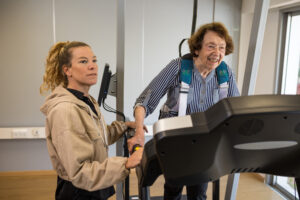Physical Therapy Interventions for Traumatic Brain Injury: Motor-cognitive VR gait training
The CDC states that there were about 61,000 TBI-related deaths in the United States in 2019 – that’s about 166 TBI-related deaths every day and is a major cause of death and disability.

This month is Brain Injury Awareness Month in the USA. The country and leading organizations, including the Brain Injury Association of America, are focused on educating people about the effects that living with brain injury can have on the injured and their families.
In this blog, we will discuss how new physical therapy interventions may bring new hope in treating traumatic brain injury (TBI).
What is Traumatic Brain Injury?
TBI is an injury that affects how the brain works and is a major cause of disability worldwide. It consists of structural injuries or physiologic changes in the function of the brain following external forces. These injuries may result in cell death, gliotic scar formation, and/or damage from reactive oxygen species and inflammation.
The prevalence of Traumatic Brain Injury in adults over 18 is estimated to be about 8.5%. Total lifetime costs range from $147 billion for fatal TBI to $18 billion for non-hospitalized TBI. (1)
Yet, today, there are few effective treatment methods for traumatic brain injury (TBI). The devastating impact of TBI resulting from sports and other recreational activities has been increasingly recognized, including not only sport-related concussions (SRCs) but also more severe injuries requiring hospitalization.
More than 30 failed clinical trials over the last few decades have pointed to an extensive but unsuccessful search for neuroprotective therapies for severe TBI, and there is still no specific neuroprotective therapy that is effective in clinical TBI. TBI patients in the acute and chronic phases require new approaches to promote recovery of function and reduce mortality.
Physical Therapy Intervention: Neuroplasticity in Traumatic Brain Injury
The primary goal of physical therapy interventions for traumatic brain injury is to recover independent movement through activating neuroplasticity.
Neuroplasticity is the central nervous system’s unique ability to recover and adapt secondary compensatory mechanisms in response to injury. Neuroplasticity is defined as the ability for neuronal circuits to make adaptive changes on both a structural and functional level, that ranges from molecular, cellular and synaptic changes to more global network changes. (2)
By performing and consistently practicing high repetitions of targeted exercises weakened by TBI, physical therapy interventions support the CNS to recover motor control through reinforcing demand for those functions and promoting neuroplasticity.
Motor-cognitive Gait Training for Traumatic Brain Injury
Various physical therapy interventions for TBI are based upon this neuroplasticity principle. However, evidence supporting the optimal timing, type, and intensity of rehabilitative interventions in patients is still limited.
Furthermore, and importantly cognitive rehabilitation in the sub-acute stage of TBI is rarely considered. It is for this reason that innovative techniques to develop and evaluate new rehabilitative interventions that both strengthen motor and cognitive function for TBI should be explored.

Virtual Reality for Treating Traumatic Brain Injury
TBI patients benefit from cognitive and physical rehabilitation programs that optimize activities, function, performance, productivity, participation, and quality of life.
Virtual reality and digital therapeutics bring a modern approach that may support TBI care teams with new neuro-restorative, motor-cognitive game plans. Virtual Reality with treadmill has been tested in numerous studies, with good results. For example in older adults at risk of falls, Multiple Sclerosis or Parkinson’s disease patients evidence of improved recovery of motor function and daily living activities is observed.
“VR allows a level of engagement and cognitive involvement, higher than the one provided by memory and imagination, but is more controlled and can be more easily measured than that offered by direct “real” experience. Its multisensory stimulation means VR can be considered an enriched environment that can offer functional and ecological real-world demands (e.g., finding objects, assembling things, and buying stuff) that may improve brain plasticity and regenerative processes.”
VR may be used both as an assessment instrument and as therapeutic intervention. An example of this type of intervention is the GaitBetter system. Using the GaitBetter interface, therapists can track and adjust the training parameters based on the personalised needs of each participant.
VR Gait Training for Falls Prevention in TBI
Furthermore, there is a high risk of falls associated with TBI. Falls prevention programs for TBI patients should consist of exercise-based interventions, including:
- Physical and cognitive activities with flexibility, strength, and dual tasking skills
- Providing stable stance, proactive and reactive balance components that address the attributes of various tasks (stability, mobility, and skills).
- Interaction with the environment (regulatory or non-regulatory)
VR in falls prevention has shown a decrease in falls, especially in the elderly, with a 70% reduction in falls. Download our case study here.
VR motor-cognitive gait training shows a promising future for supporting patients with TBI and caregivers. To learn more about implementing a semi-immersive VR system to your treadmill, schedule a meeting with GaitBetter today.
